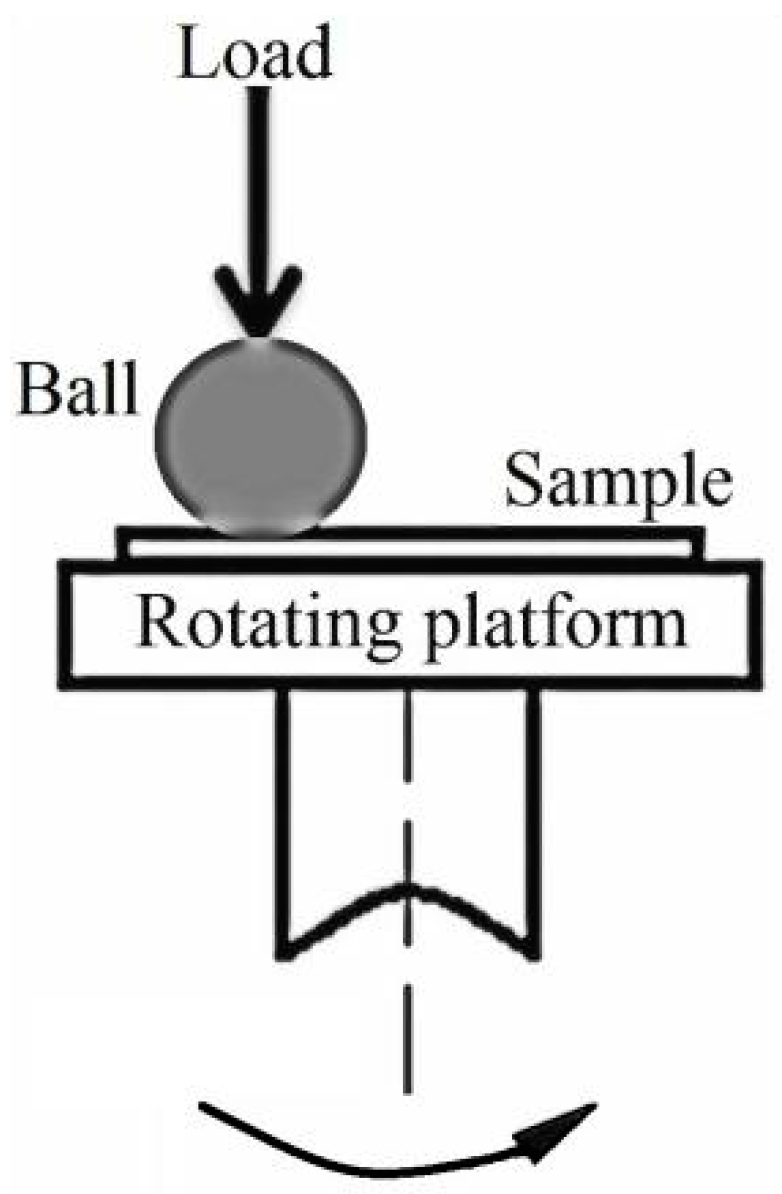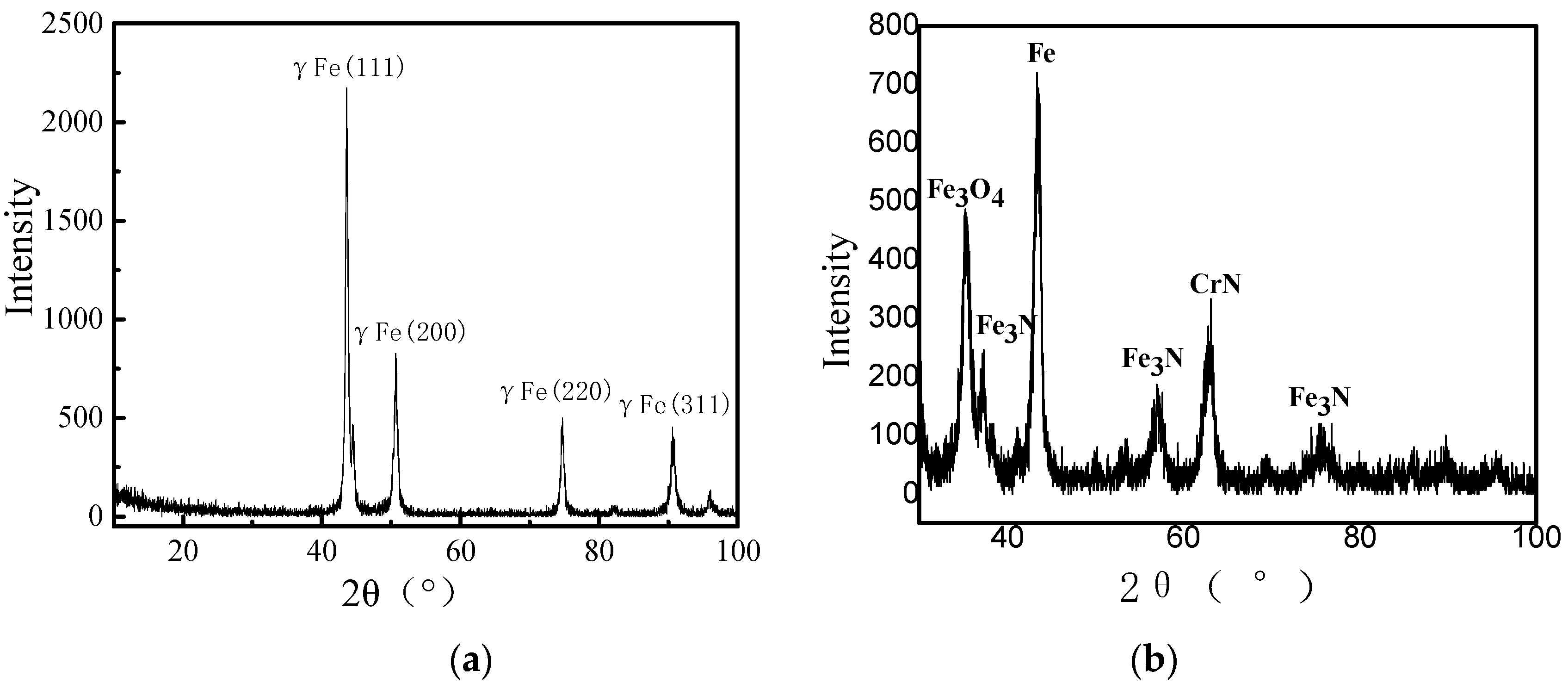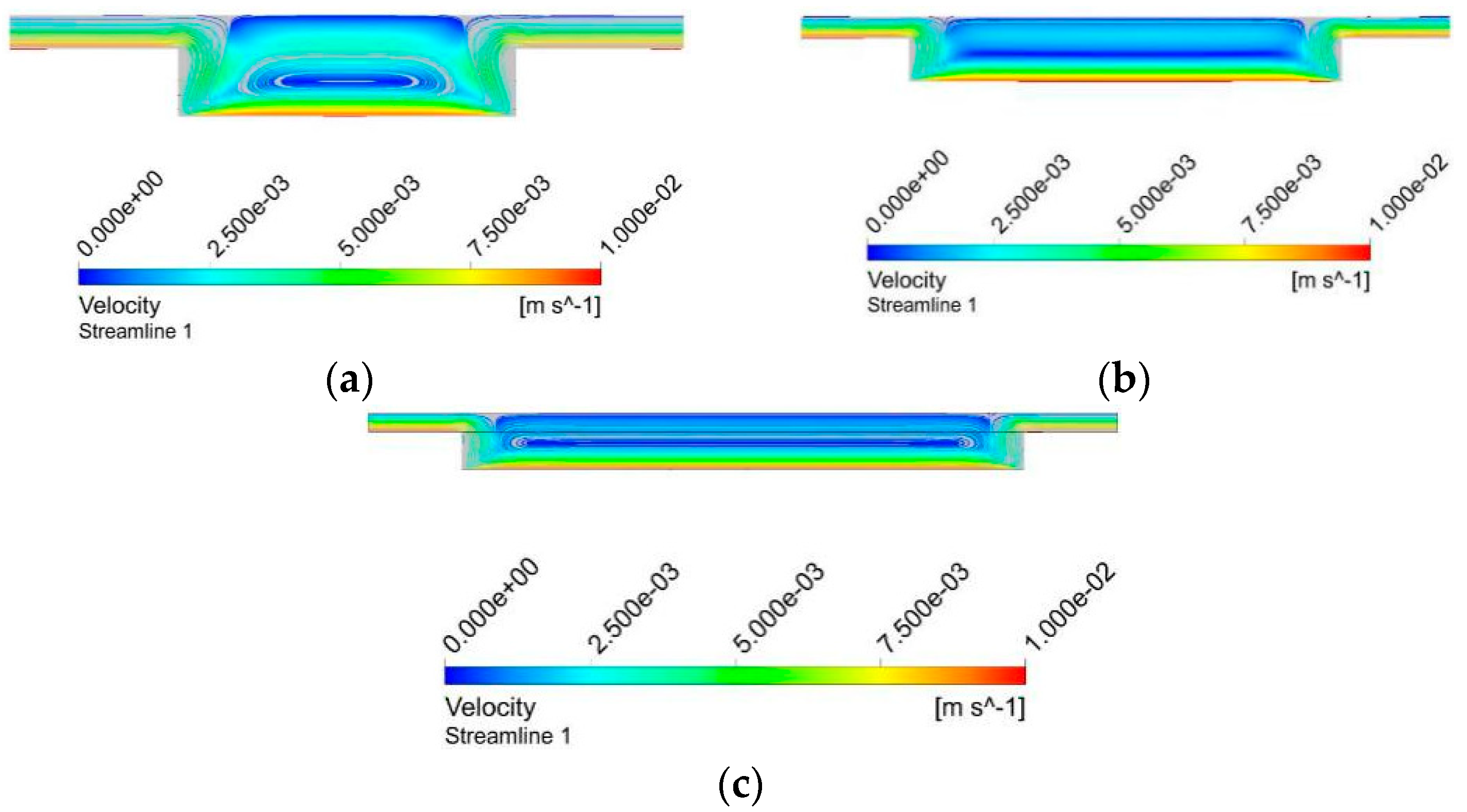Study on the Anti-Friction Mechanism of Nitriding Surface Texture 304 Steel
Abstract
1. Introduction
2. Experimental Materials and Processes
3. Experimental Results and Discussion
3.1. Properties of Materials after Nitriding in Salt Bath
3.1.1. Surface Phase Composition and Nitriding Thickness
3.1.2. Surface Microhardness
3.1.3. Surface Apparent Contact Angle
3.1.4. Surface Work Function
3.2. Surface Morphology after Laser Texturing
3.3. Friction and Wear Characteristics
4. Summary
- The CrN phase with high hardness is precipitated in the nitrided surface layer, which causes the obvious increase of surface hardness. The free energy of the material surface is decreased after nitriding in the salt bath. As the surface free energy is higher, the organization becomes more unstable. The electronic work function of the material surface increases after nitriding, which is directly related to the stability of the material surface and the possibility of reconstruction. There is an inverse relationship between surface energy and its work function;
- The surface wear resistance of the nitrided surface is better than the 304 surface. The reason for this phenomenon is that the surface hardness is greatly increased due to nitriding. Moreover, the work function of the nitriding surface is large, and the surface free energy is small, which leads to the difficulty of dissection of the abrasive particles from the surface of the matrix;
- The micro dimple will lead to the change of liquid streamline, promote the change of liquid pressure in different regions and result in convergence and divergence regions. But the dynamic pressure of the oil in the micro texture did not play an obvious role in reducing friction at a lower speed;
- The anti-friction and anti-wear properties of the compound-modified surface are better than those of the nitriding smooth surface, which are mainly attributed to lubricant storage in the texture and reduction of the real contact area.
Author Contributions
Funding
Conflicts of Interest
References
- Li, C.; Yin, Y.; Guo, L.; Qin, L. Effect of Boron and Molybdenum Alloying Treatment on Abrasion Resistance of 304 Stainless Steel. Hot Work. Technol. 2015, 44, 144–146. (In Chinese) [Google Scholar]
- Wang, M. Effect of Combined Treatment with Plasma Nitriding and Laser Surface TEXTURING on Microstructure and Vacuum Tribological Properties of Titanium Alloy. Master’s Thesis, China University of Geosciences, Beijing, China, 2018. [Google Scholar]
- Olofinjanal, B.; Martin, C.L.; Ajayi, O.O.; Ajayi, E.O. Effect of laser surface texturing(LST) on tribochemical films dynamics and friction and wear performance. Wear 2015, 332, 1225–1230. [Google Scholar] [CrossRef]
- Liu, H.B.; Wan, D.P.; Hu, D.J. Microstructure and wear behavior of laser textured and micro-alloyed Co-based WC and TiC composite sintered-car bide coating. J. Mater. Process. Technol. 2009, 209, 805. [Google Scholar] [CrossRef]
- Sun, Q.C.; Hu, T.C.; Fan, H.Z.; Zhang, Y.; Hu, L. Dry sliding wear behavior of TC11 alloy at 500 ℃: Influence of laser surface texturing. Tribol. Int. 2015, 92, 136. [Google Scholar] [CrossRef]
- Etsion, I. State of the art in laser surface texturing. J. Tribol. 2005, 127, 248–253. [Google Scholar] [CrossRef]
- Rahnejat, H.; Balakrishnan, S.; King, P.D.; Howell-Smith, S. In-cylinder friction reduction using a surface finish optimization technique. Proc. Inst. Mech. Eng. Part D J. Automob. Eng. 2006, 220, 1309–1318. [Google Scholar] [CrossRef]
- Yu, H.; Huang, W.; Wang, X. Dimple patterns design for different circumstances. Lubr. Sci. 2013, 25, 67–78. [Google Scholar] [CrossRef]
- Wang, J.; Wang, X. State of the art in innovative design of surface texture. J. Mech. Eng. 2015, 51, 84–95. [Google Scholar] [CrossRef]
- Han, J.; Fang, L.; Sun, J.; Ge, S. Hydrodynamic lubrication of microdimple textured surface using three- dimensional CFD. Tribol. Trans. 2010, 53, 860–870. [Google Scholar] [CrossRef]
- Zhang, J.; Meng, Y. Optimal design of surface texture in parallel thrust bearings. J. Mech. Eng. 2012, 48, 91–99. [Google Scholar] [CrossRef]
- Yin, B.; Lu, Z.; Liu, S.; Fu, Y.; Wang, Y. Theoretical and experimental research on lubrication performance of laser surface texturing cylinder liner. J. Mech. Eng. 2012, 48, 91–96. [Google Scholar] [CrossRef]
- Ma, C.; Zhu, H.; Sun, J. Applicable equation study of lubrication calculation of surface texture based on CFD analysis. J. Mech. Eng. 2011, 47, 95–106. [Google Scholar] [CrossRef]
- Suh, N.P.; Mosleh, M.; Howard, P.S. Control of friction. Wear 1994, 175, 151–158. [Google Scholar] [CrossRef]
- Wang, X.; Kato, K. Improving the anti-seizure ability of SiC seal in water with RIE texturing. Tribol. Lett. 2003, 14, 275–280. [Google Scholar] [CrossRef]
- Jacquet, P.; Coudert, J.B.; Lourdin, P. How different steel grades react to a salt bath nitrocarburizing and post-oxidation process: Influence of alloying elements. Surf. Coat. Technol. 2011, 205, 4064–4067. [Google Scholar] [CrossRef]
- Cai, W.; Meng, F.N.; Gao, X.Y.; Hu, J. Effect of QPQ nitriding time on wear and corrosion behavior of 45 carbon steel. Appl. Surf. Sci. 2012, 261, 411–414. [Google Scholar] [CrossRef]
- Fu, H.; Zhang, J.; Wu, S.; Huang, J.F.; Gao, W.; Lian, Y. Effect of low-temperature salt bath nitriding on the corrosion and wear resistance of custom 465. Chin. J. Eng. 2016, 38, 235–240. [Google Scholar]
- Wang, H. Effect of low temperature nitriding on surface modification of pump with 0Cr13Ni4Mo steel. Foundry 2016, 65, 783–786. [Google Scholar]
- Wang, Y.; Wang, L. Research progress of electron work function on the wear and corrosion behavior of materials. Chin. Mater. Sci. Technol. Equip. 2011, 5, 1–5. (In Chinese) [Google Scholar]
- Chen, W.; Liu, X.; Zheng, L. Study on the friction characteristics of 304 steel with composite surface modification. Ind. Lubr. Tribol. 2017, 69, 248–258. [Google Scholar] [CrossRef]
- Li, G.; Peng, Q.; Li, C.; Wang, Y.; Chen, S.; Wang, J.; Shen, B. Study on micro-structure of a QPQ complex salt bath heat-treated 17-4 Ph stainless steel. Nuclear Power Eng. 2007, 28, 59–62. [Google Scholar]
- Li, J.; Sun, F.; Wang, S.; Yang, X.; Hu, J. Catalysis effect and mechanism of pre-oxidation on direct current plasma nitriding. Trans. Mater. Heat Treat. 2014, 35, 182–187. (In Chinese) [Google Scholar]
- Ji, D.; Wang, S. Study of surface energy and work function of hex metals by first-principles calculation. Acta Metall. Sin. 2015, 51, 597–602. [Google Scholar]
- Yoshimitsu, T.; Nakajima, H.; Nagaoka, H. Synthesis of the CD ring system of paclitaxel by atom- transfer radical annulation reaction. Tetrahedron Lett. 2002, 43, 8587. [Google Scholar] [CrossRef]
- Lu, H.; Hua, G.M.; Li, D.Y. Dependence of the mechanical behavior of alloys on their electron work function—An alternative parameter for materials design. Appl. Phys. Lett. 2013, 103, 261902. [Google Scholar] [CrossRef]
- Roach, P.; Shirtcliffe, N.J.; Newton, M.I. Progress in superhydrophobic surface development. Soft Matter 2008, 4, 224–240. [Google Scholar] [CrossRef]
















| Serial No. | 304 Steel (eV) | Nitriding Surface (eV) |
|---|---|---|
| 1 | −612.5 | 737.3 |
| 2 | −569.1 | 760.2 |
| 3 | −542.4 | 762.8 |
| 4 | −548.7 | 729.2 |
| 5 | −541.9 | 523.2 |
| Average | −562.9 | 702.5 |
| Samples | Wear Marks Width (μm) | Deepest Depth of the Wear Marks (μm) |
|---|---|---|
| 304 steel | 516.9 | 6.5 |
| Nitrided surface | 419.7 | 5.5 |
| 100 μm surface | 457.3 | 2.6 |
| 200 μm surface | 457.3 | 4.2 |
| 300 μm surface | 401.2 | 3.4 |
© 2020 by the authors. Licensee MDPI, Basel, Switzerland. This article is an open access article distributed under the terms and conditions of the Creative Commons Attribution (CC BY) license (http://creativecommons.org/licenses/by/4.0/).
Share and Cite
Chen, W.; Xia, M.; Song, W. Study on the Anti-Friction Mechanism of Nitriding Surface Texture 304 Steel. Coatings 2020, 10, 554. https://doi.org/10.3390/coatings10060554
Chen W, Xia M, Song W. Study on the Anti-Friction Mechanism of Nitriding Surface Texture 304 Steel. Coatings. 2020; 10(6):554. https://doi.org/10.3390/coatings10060554
Chicago/Turabian StyleChen, Wengang, Minhua Xia, and Wentao Song. 2020. "Study on the Anti-Friction Mechanism of Nitriding Surface Texture 304 Steel" Coatings 10, no. 6: 554. https://doi.org/10.3390/coatings10060554
APA StyleChen, W., Xia, M., & Song, W. (2020). Study on the Anti-Friction Mechanism of Nitriding Surface Texture 304 Steel. Coatings, 10(6), 554. https://doi.org/10.3390/coatings10060554





